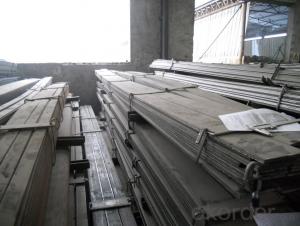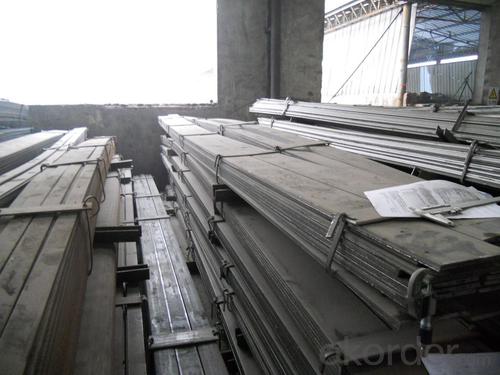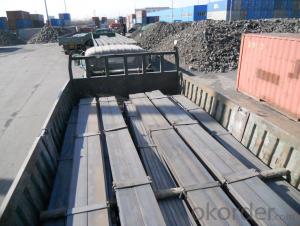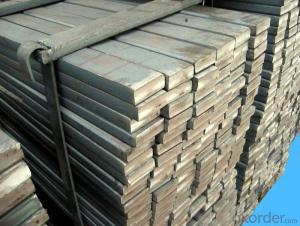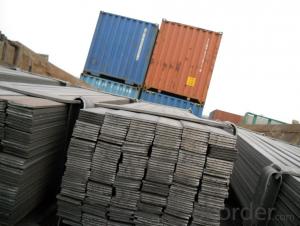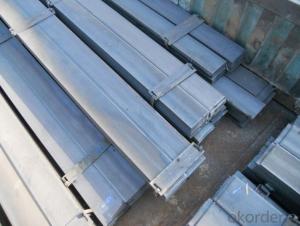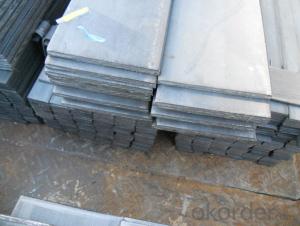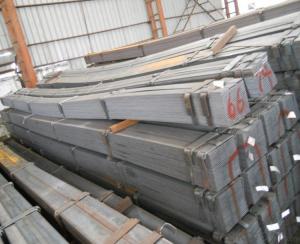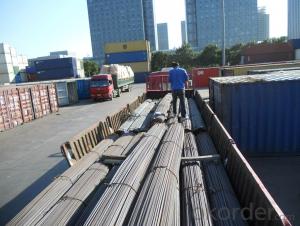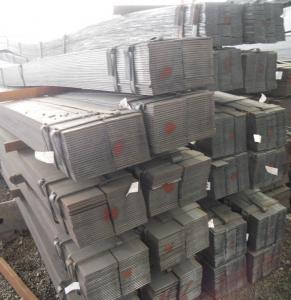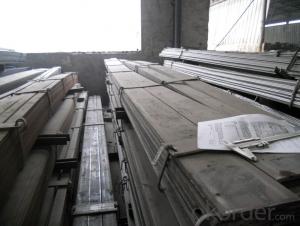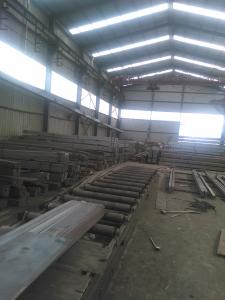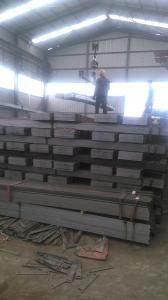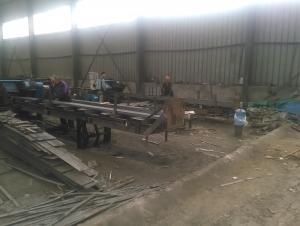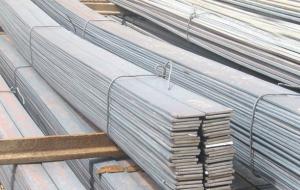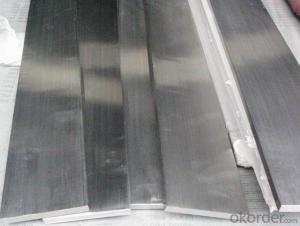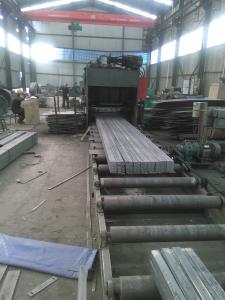Stainless Q235/275 Alloyed Mild Steel Flat Bar with High Quality
- Loading Port:
- Tianjin
- Payment Terms:
- TT OR LC
- Min Order Qty:
- 50 m.t.
- Supply Capability:
- 1000 m.t./month
OKorder Service Pledge
OKorder Financial Service
You Might Also Like
Product Description:
OKorder is offering Stainless Q235/275 Alloyed Mild Steel Flat Bar with High Quality with Leigth 6M/12M at great prices with worldwide shipping. Our supplier is a world-class manufacturer of steel, with our products utilized the world over. OKorder annually supplies products to European, North American and Asian markets. We provide quotations within 24 hours of receiving an inquiry and guarantee competitive prices.
Product Applications:
Stainless Q235/275 Alloyed Mild Steel Flat Bar with High Quality are ideal for structural applications and are widely used in the construction of buildings and bridges, and the manufacturing, petrochemical, and transportation industries.
Product Advantages:
OKorder's Stainless Q235/275 Alloyed Mild Steel Flat Bar with High Quality are durable, strong, and resist corrosion.
Main Product Features:
· Premium quality
· Prompt delivery & seaworthy packing (30 days after receiving deposit)
· Corrosion resistance
· Can be recycled and reused
· Mill test certification
· Professional Service
· Competitive pricing
Specifications of Stainless Q235/275 Alloyed Mild Steel Flat Bar with High Quality
1. Invoicing on theoretical weight or actual weight as customer request
2. Length: 6m, 12m as following table
3. Sizes:
Galvanized Flat Bar Zinc Thickness:15-80μ
Grade: A36, SS400, Q235, Q195
Standard: ASTM, JIS, GB
Thickness:1.5mm-20mm
Width: 10mm-250mm
Width | Thickness | Width | Thickness | Width | Thickness |
(mm) | (mm) | (mm) | (mm) | (mm) | (mm) |
8 | 5-7 | 50 | 5-25 | 200 | 8-40 |
10 | 3-9 | 55 | 5-25 | 220 | 8-40 |
12 | 3-9 | 60 | 5-25 | 250 | 8-40 |
13 | 5-11 | 65 | 5-25 | 260 | 8-40 |
14 | 3-12 | 70 | 5-25 | 270 | 8-40 |
15 | 5-12 | 75 | 5-25 | 280 | 8-40 |
16 | 4-14 | 80 | 6-25 | 290 | 8-40 |
18 | 4-16 | 85 | 6-25 | 300 | 8-40 |
20 | 4-18 | 90 | 6-25 | 310 | 8-40 |
22 | 4-20 | 95 | 6-25 | 320 | 8-40 |
24 | 5-20 | 100 | 6-25 | 330 | 8-40 |
25 | 4-20 | 105 | 6-25 | 340 | 8-40 |
28 | 4-20 | 110 | 6-25 | 350 | 8-40 |
30 | 4-25 | 120 | 7-25 | 360 | 8-40 |
32 | 4-25 | 125 | 7-25 | 370 | 8-40 |
35 | 4-25 | 130 | 8-25 | 380 | 8-40 |
36 | 6-25 | 140 | 8-25 | 390 | 8-40 |
38 | 7-25 | 150 | 8-25 | 400 | 8-40 |
40 | 4-25 | 160 | 8-40 | ||
45 | 4-25 | 180 | 8-40 |
5. Material Specifications:
Production Standard: GB/T 700-2006 | |||||
Grade | Chemical composition (%,max) | ||||
C | Si | Mn | P | S | |
Q195 | 0.12 | 0.30 | 0.50 | 0.035 | 0.040 |
Q235A | 0.22 | 0.35 | 1.40 | 0.045 | 0.050 |
Q235B | 0.20 | 0.35 | 1.40 | 0.045 | 0.045 |
Q235C | 0.17 | 0.35 | 1.40 | 0.040 | 0.040 |
Q235D | 0.17 | 0.35 | 1.40 | 0.035 | 0.035 |
Q235 is similar to ASTMA36,JIS SS400
Usage & Applications of Stainless Galvanized Flat Bar of High Quanlity with Leigth 6M/12M
Widely used for construction,Fabrication , Ship building, Machinery manufacturing, Steel structure
Packaging & Delivery of Stainless Q235/275 Alloyed Mild Steel Flat Bar with High Quality
1. Packing: it is nude packed in bundles by steel wire rod
2. Bundle weight: not more than 3.5MT for bulk vessel; less than 3 MT for container load
3. Marks:
Color marking: There will be color marking on both end of the bundle for the cargo delivered by bulk vessel. That makes it easily to distinguish at the destination port.
Tag mark: there will be tag mark tied up on the bundles. The information usually including supplier logo and name, product name, made inChina, shipping marks and other information request by the customer.
4. Transportation: the goods are delivered by truck from mill to loading port, the maximum quantity can be loaded is around 40MTs by each truck. If the order quantity cannot reach the full truck loaded, the transportation cost per ton will be little higher than full load.
5. Delivered by container or bulk vessel
Production flow of Stainless Q235/275 Alloyed Mild Steel Flat Bar with High Quality
The process of hot-dip galvanizing results in a metallurgical bond between zinc and steel with a series of distinct iron-zinc alloys. The resulting coated steel can be used in much the same way as uncoated.
A typical hot-dip galvanizing line operates as follows:
Steel is cleaned using a caustic solution. This removes oil/grease, dirt, and paint.
The caustic cleaning solution is rinsed off.
The steel is pickled in an acidic solution to remove mill scale.
The pickling solution is rinsed off.
A flux, often zinc ammonium chloride is applied to the steel to inhibit oxidation of the cleaned surface upon exposure to air. The flux is allowed to dry on the steel and aids in the process of the liquid zinc wetting and adhering to the steel.
The steel is dipped into the molten zinc bath and held there until the temperature of the steel equilibrates with that of the bath.
The steel is cooled in a quench tank to reduce its temperature and inhibit undesirable reactions of the newly formed coating with the atmosphere.
FAQ:
Q1: Why buy Materials & Equipment from OKorder.com?
A1: All products offered byOKorder.com are carefully selected from China's most reliable manufacturing enterprises. Through its ISO certifications, OKorder.com adheres to the highest standards and a commitment to supply chain safety and customer satisfaction.
Q2: How do we guarantee the quality of our products?
A2: We have established an advanced quality management system which conducts strict quality tests at every step, from raw materials to the final product. At the same time, we provide extensive follow-up service assurances as required.
Q3: How soon can we receive the product after purchase?
A3: Within three days of placing an order, we will begin production. The specific shipping date is dependent upon international and government factors, but is typically 7 to 10 workdays.
Q4: What makes stainless steel stainless?
A4: Stainless steel must contain at least 10.5 % chromium. It is this element that reacts with the oxygen in the air to form a complex chrome-oxide surface layer that is invisible but strong enough to prevent further oxygen from "staining" (rusting) the surface. Higher levels of chromium and the addition of other alloying elements such as nickel and molybdenum enhance this surface layer and improve the corrosion resistance of the stainless material.
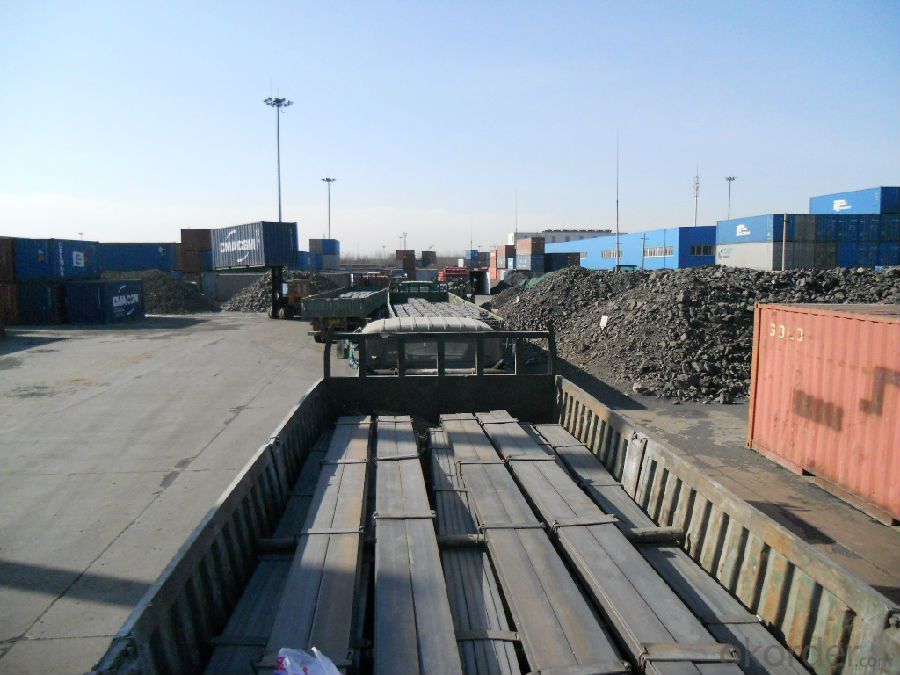
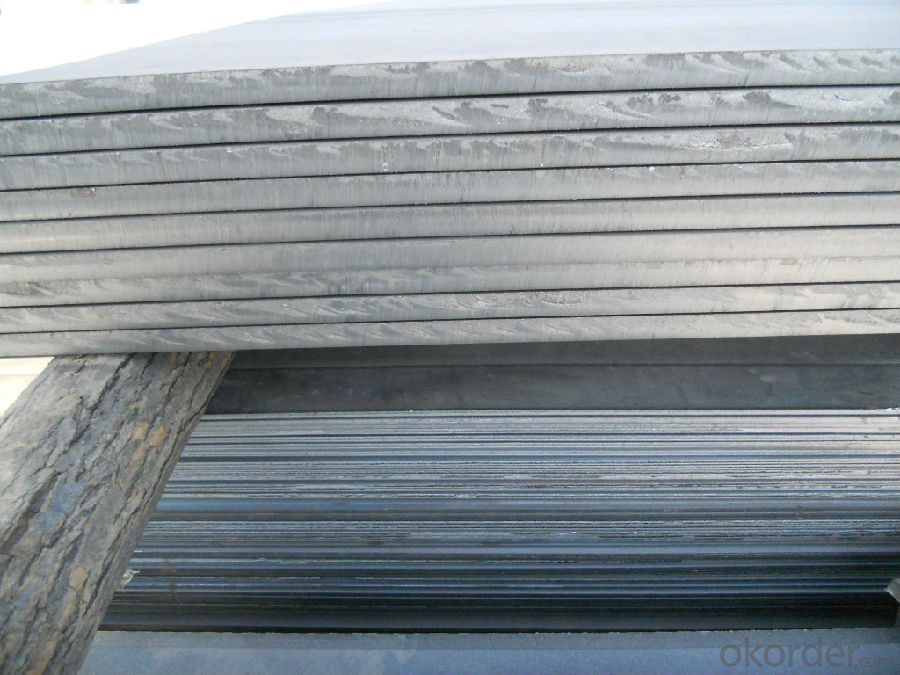
- Q: Are steel flat bars resistant to fire or heat?
- Steel flat bars are highly resistant to fire and heat. Steel is a non-combustible material, which means it does not burn or contribute to the spread of fire. In fact, steel has a high melting point, making it able to withstand extremely high temperatures without losing its structural integrity. This property is especially important in applications where fire resistance is critical, such as in the construction of buildings, bridges, and industrial equipment. Steel flat bars have been extensively tested and proven to maintain their strength and stability even under prolonged exposure to intense heat. Therefore, steel flat bars are considered a safe and reliable choice in fire-prone environments.
- Q: How do you prevent warping or distortion of steel flat bars during heat treatment?
- To prevent warping or distortion of steel flat bars during heat treatment, there are several key measures that can be taken. 1. Proper selection of steel grade: It is crucial to choose a steel grade that is less prone to warping or distortion during heat treatment. Some steel grades have better dimensional stability, such as low alloy steels, which can help minimize these effects. 2. Uniform heating and cooling: Ensuring a uniform and controlled heating and cooling process is essential. This can be achieved through the use of proper heating equipment, such as industrial furnaces with well-distributed heat sources. It is important to avoid localized heating or cooling, as this can lead to uneven expansion or contraction, causing warping or distortion. 3. Preheating: Preheating the steel flat bars before heat treatment can help alleviate internal stresses and reduce the risk of warping. This can be done by gradually increasing the temperature to the desired level in a controlled manner. 4. Proper fixturing: The use of appropriate fixtures or jigs during heat treatment can help support the steel flat bars and minimize distortion. Fixtures should be designed to evenly distribute the load and prevent bending or twisting during the heating and cooling process. 5. Slow cooling: Rapid cooling can induce internal stresses, leading to warping or distortion. Therefore, it is recommended to cool the steel flat bars slowly after heat treatment. This can be achieved by placing them in an insulated container or furnace, or by using heat sinks to control the cooling rate. 6. Stress-relieving treatment: After heat treatment, a stress-relieving treatment can be applied to further reduce internal stresses. This involves heating the steel flat bars to a specific temperature and holding it for a certain period of time, followed by a controlled cooling process. Stress-relieving can help restore dimensional stability and minimize warping or distortion. By following these preventive measures, it is possible to minimize the warping or distortion of steel flat bars during heat treatment, ensuring that the desired properties are achieved while maintaining dimensional integrity.
- Q: Can steel flat bars be used for manufacturing agricultural implements?
- Certainly, agricultural implements can be manufactured using steel flat bars. Steel, being a robust and enduring material, is well-suited for various purposes, including agricultural machinery. The framework or structural elements of implements like plows, cultivators, and harrows can be fashioned from flat bars. The flat shape of these bars facilitates effortless fabrication and welding, making them a versatile option for production. Moreover, steel flat bars can undergo heat treatment or galvanization to bolster their strength and corrosion resistance, guaranteeing that the agricultural implements endure the demanding conditions of farming and have a prolonged lifespan.
- Q: What is the minimum yield strength of a steel flat bar?
- The grade of steel being used determines the minimum yield strength of a steel flat bar. Each grade of steel has its own specific minimum yield strength. Take, for instance, the commonly used grade A36, which boasts a minimum yield strength of 36,000 PSI. Nevertheless, there are stronger grades available, like A572, with a minimum yield strength of 50,000 PSI. To determine the suitable grade and minimum yield strength for a steel flat bar, it is crucial to refer to the specifications and requirements of the particular project or application.
- Q: How do you prevent pitting or cracking on steel flat bars?
- To prevent pitting or cracking on steel flat bars, there are several measures that can be taken: 1. Proper Storage: Ensure that the steel flat bars are stored in a dry and well-ventilated area to prevent exposure to moisture. Moisture can lead to corrosion and pitting. 2. Protective Coatings: Apply a suitable protective coating on the steel flat bars to create a barrier against moisture and other corrosive elements. Common coatings include paint, varnish, or specialized anti-corrosion coatings. 3. Regular Cleaning: Regularly clean the steel flat bars to remove any dirt, debris, or corrosive substances that might accumulate on the surface. Use mild detergents or specialized cleaning solutions that are safe for steel. 4. Avoiding Impact or Overloading: Handle the steel flat bars with care to prevent any impact or excessive loads that can lead to cracking. Avoid dropping or mishandling the bars during storage, transportation, or installation. 5. Proper Handling and Transportation: When moving or transporting steel flat bars, ensure they are properly secured to prevent any movement or rubbing against each other, which can cause pitting or scratching. 6. Avoid Exposure to Extreme Temperatures: Steel flat bars should be protected from extreme temperatures, especially rapid cooling or heating, as this can cause thermal stress and potential cracking. Allow the bars to gradually acclimate to temperature changes when possible. 7. Regular Maintenance: Inspect the steel flat bars periodically to identify any signs of pitting, cracking, or corrosion. Promptly address any issues by cleaning, repairing, or applying protective coatings as necessary. By implementing these preventive measures, you can minimize the risk of pitting or cracking on steel flat bars, ensuring their longevity and preserving their structural integrity.
- Q: Are steel flat bars commonly used in the renewable energy sector?
- Yes, steel flat bars are commonly used in the renewable energy sector. They are often used for various applications such as structural support, framing, and mounting systems for solar panels and wind turbines. Steel flat bars are valued for their strength, durability, and versatility, making them an ideal choice for renewable energy infrastructure projects.
- Q: How are steel flat bars shipped?
- Steel flat bars are typically shipped in bundles or on pallets. They are securely strapped together to prevent movement during transit. Depending on the quantity and size, they can be transported by trucks, railcars, or shipping containers.
- Q: Can steel flat bars be used for making brackets or supports for lighting fixtures?
- Yes, steel flat bars can definitely be used for making brackets or supports for lighting fixtures. Steel is a strong and durable material that can provide the necessary support and stability required for holding up lighting fixtures. Additionally, steel is resistant to corrosion and can withstand heavy loads, making it a reliable choice for such applications. The flat shape of steel bars allows for easy fabrication and customization to meet specific design requirements. Moreover, steel can be easily welded, drilled, or bent to create brackets or supports that can securely hold lighting fixtures in place. Overall, steel flat bars are a suitable and commonly used material for making brackets or supports for lighting fixtures.
- Q: How do you prevent discoloration or staining on steel flat bars during fabrication?
- One way to prevent discoloration or staining on steel flat bars during fabrication is by applying a protective coating or finish to the surface. This can be done using methods such as painting, powder coating, or galvanizing. Additionally, proper storage and handling of the steel flat bars, ensuring they are kept dry and protected from moisture, can also help prevent discoloration or staining.
- Q: What is the maximum length-to-thickness ratio for a steel flat bar?
- The maximum length-to-thickness ratio for a steel flat bar is typically determined by industry standards and engineering specifications. In general, the maximum recommended length-to-thickness ratio for a steel flat bar is around 160:1. This means that the length of the bar can be up to 160 times its thickness. However, it is important to note that this maximum ratio may vary depending on the specific application and intended use of the steel flat bar. Different industries and engineering disciplines may have their own guidelines and recommendations for maximum length-to-thickness ratios based on factors such as load-bearing capacity, structural stability, and safety considerations. It is always advisable to consult relevant codes, standards, and engineering guidelines specific to the application in order to determine the appropriate maximum length-to-thickness ratio for a steel flat bar. Professional engineers and experts in the field can provide valuable insights and calculations to ensure the structural integrity and safety of the steel flat bar in a given application.
Send your message to us
Stainless Q235/275 Alloyed Mild Steel Flat Bar with High Quality
- Loading Port:
- Tianjin
- Payment Terms:
- TT OR LC
- Min Order Qty:
- 50 m.t.
- Supply Capability:
- 1000 m.t./month
OKorder Service Pledge
OKorder Financial Service
Similar products
Hot products
Hot Searches
Related keywords
